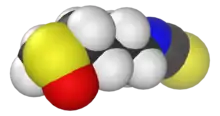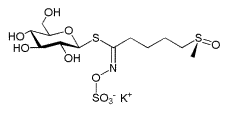Sulforaphane
 | |
 | |
 | |
| Names | |
|---|---|
| Preferred IUPAC name
1-Isothiocyanato-4-(methanesulfinyl)butane | |
| Identifiers | |
CAS Number |
|
3D model (JSmol) |
|
| ChEBI | |
| ChEMBL | |
| ChemSpider | |
PubChem CID |
|
| UNII | |
CompTox Dashboard (EPA) |
|
InChI
| |
SMILES
| |
| Properties | |
Chemical formula |
C6H11NOS2 |
| Molar mass | 177.29 g/mol |
Except where otherwise noted, data are given for materials in their standard state (at 25 °C [77 °F], 100 kPa).
Infobox references | |
Sulforaphane (sometimes sulphoraphane in British English) is a compound within the isothiocyanate group of organosulfur compounds.[1] It is produced when the enzyme myrosinase transforms glucoraphanin, a glucosinolate, into sulforaphane upon damage to the plant (such as from chewing or chopping during food preparation), which allows the two compounds to mix and react.
Sulforaphane is present in cruciferous vegetables, such as broccoli, Brussels sprouts, and cabbage.[1]
 Glucoraphanin, the glucosinolate precursor to sulforaphane |
Occurrence and isolation
Sulforaphane occurs in broccoli sprouts, which, among cruciferous vegetables, have the highest concentration of glucoraphanin, the precursor to sulforaphane.[1][2] It is also found in cabbage, cauliflower, Brussels sprouts, bok choy, kale, collards, mustard greens, and watercress.[1]
Research
Although there has been some basic research on how sulforaphane might have effects in vivo, there is no clinical evidence that consuming cruciferous vegetables and sulforaphane affects the risk of cancer or any other disease, as of 2017.[1][3] Sulforaphane is studied for its potential to counteract neurodegenerative diseases such as Alzheimer's disease, Parkinson's disease (PD), and multiple sclerosis.[4] A phase 2 clinical trial is due to be completed in December 2022 to evaluate the efficacy and safety of sulforaphane in PD patients.[5]
See also
- Raphanin
References
- "Isothiocyanates". Micronutrient Information Center, Linus Pauling Institute, Oregon State University. 1 April 2017. Retrieved 14 July 2022.
- Houghton, C. A.; Fassett, R. G.; Coombes, J. S. (2013). "Sulforaphane: Translational research from laboratory bench to clinic". Nutrition Reviews. 71 (11): 709–26. doi:10.1111/nure.12060. PMID 24147970.
- van Die, MD; Bone, KM; Emery, J; Williams, SG; Pirotta, MV; Paller, CJ (April 2016). "Phytotherapeutic interventions in the management of biochemically recurrent prostate cancer: a systematic review of randomised trials". British Journal of Urology International. 117 (S4): 17–34. doi:10.1111/bju.13361. PMC 8631186. PMID 26898239.
- Schepici, Giovanni; Bramanti, Placido; Mazzon, Emanuela (16 November 2020). "Efficacy of Sulforaphane in Neurodegenerative Diseases". International Journal of Molecular Sciences. 21 (22): E8637. doi:10.3390/ijms21228637. ISSN 1422-0067. PMC 7698208. PMID 33207780.
- Wu,PhD, Renrong (18 October 2021). "A 6-month Study to Evaluate Sulforaphane Effects in Treatment of Cognition Impairment of PD Patients". Central South University.
{{cite journal}}: Cite journal requires|journal=(help)